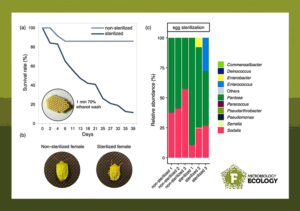Insects have long been known to harbour beneficial bacteria that help them survive and thrive in the ecosystem. In these symbiotic relationships, both partners benefit from nutrient exchange and protection from the environment. The study “From eggs to guts: Symbiotic association of Sodalis nezarae sp. nov. with the Southern green shield bug Nezara viridula” in FEMS Microbiology Ecology identified both a new bacterial species and symbiotic insect-microbe relationship, as explained by Magda Rogowska-van der Molen in this #FEMSmicroBlog. #FascinatingMicrobes
A novel bacterium and its symbiotic relationship
In symbiotic insect-bacteria relationships, the host insect provides a stable environment and nutrients for bacteria. Bacteria, in turn, aid the insect by digesting, supplementing essential nutrients, and protecting against plant toxins to overcome plant defences.
The Southern green shield bug (Nezara viridula) is a global agricultural pest, damaging crops such as soybeans, tomatoes, and bell peppers. Understanding its biology, including its relationships with essential symbiotic bacteria, could help develop new targeted pest control strategies that are more sustainable than conventional pesticides.
Most research on shield bugs has focused on their gut microbiota, which is dominated by Pantoea, a common symbiont in plant-feeding insects. However, the study “From eggs to guts: Symbiotic association of Sodalis nezarae sp. nov. with the Southern green shield bug Nezara viridula” in FEMS Microbiology Ecology discovered a new bacterial species, Sodalis nezarae, in the insect’s salivary glands and uncovered an intimate relationship between the two.
Sodalis symbionts were first isolated from tsetse flies, with many more species having been discovered. The Sodalis genus includes both free-living and symbiotic bacteria. Being considered a model for studying endosymbiosis in insects, the discovery of Sodalis nezarae opens new exciting opportunities for understanding host-microbe interactions.
This study found Sodalis nezarae to be present in the insect’s organs, with a striking dominance in the salivary glands. This suggests that Sodalis nezarae may be transmitted to plants when the bugs feed on them.
Once inside the plant, Sodalis nezarae represses the biosynthesis of plant toxins to decrease plant defence. This helps the bug feed more effectively on crops and renders the bacterium a key player in pest success and plant susceptibility.
Passing on symbionts via infected eggs
The study showed that Sodalis nezarae is transmitted from mother to offspring via the eggs. Surprisingly, Sodalis nezarae was not just present on the surface of fertilised shield bug eggs, but also inside them.
While the external microbiome is typical for shield bugs, the presence of an internal microbiome might be crucial for its persistence. Passed on from one generation to the next, it would ensure the microbe’s survival when external conditions might disturb or eliminate microbes on the surface of the egg.
When removing Sodalis nezarae from the egg surface, insects suffered from stunted growth, lost their green colouration, and failed to reach maturity. These results indicate the substantial role Sodalis nezarae plays in insect development.
Additionally, the study also found the bacteria in the reproductive organs of male shield bugs. This hints at a potential role for the male bugs in symbiont transmission.

Targeting bacterial symbionts as a novel pest control
The findings of Sodalis nezarae as an essential partner for the pest insect Nezara open up exciting possibilities for pest control. By disrupting the transmission or function of these bacteria, we might be able to weaken the pest population without harming beneficial insects or the environment. In conclusion, this study highlights insect-microbe interactions and how they shape ecosystems, potentially unlocking promising solutions for sustainable agriculture.
- Read the article “From eggs to guts: Symbiotic association of Sodalis nezarae sp. nov. with the Southern green shield bug Nezara viridula” by Rogowska-van der Molenet et al. in FEMS Microbiology Ecology (2024).

Magda Rogowska-van der Molen is a Postdoctoral fellow at Dr Jeanne Salje’s lab at the Cambridge Institute for Medical Research at the University of Cambridge. Here, she investigates host-microbe interactions and develops an arthropod model system to study obligate intracellular pathogens such as Orientia tsutsugamushi. Her research interests revolve around understanding the interplay between symbiosis and pathogenesis in complex relationships between arthropod vectors and the pathogens they transmit. She integrates metabolomics to explore how metabolic changes in the arthropod hosts affect pathogen lifecycle and virulence, uncovering novel biomarkers and metabolic pathways that can be targeted for disease prevention.
About this blog section
The section #FascinatingMicrobes for the #FEMSmicroBlog explains the science behind a paper and highlights the significance and broader context of a recent finding. One of the main goals is to share the fascinating spectrum of microbes across all fields of microbiology.
| Do you want to be a guest contributor? |
| The #FEMSmicroBlog welcomes external bloggers, writers and SciComm enthusiasts. Get in touch if you want to share your idea for a blog entry with us! |
